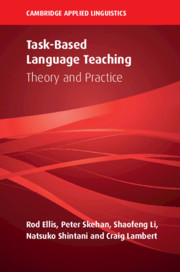Book contents
- Task-Based Language Teaching
- The Cambridge Applied Linguistics Series
- Task-Based Language Teaching
- Copyright page
- Contents
- Figures
- Tables
- Series Editors’ Preface
- Authors’ Preface
- Part I Introduction
- Part II Theoretical Perspectives
- 2 Cognitive-Interactionist Perspectives
- 3 Psycholinguistic Perspectives
- 4 Sociocultural Perspectives
- 5 Psychological Perspectives
- 6 Educational Perspectives
- Part III Pedagogical Perspectives
- Part IV Investigating Task-Based Programmes
- Part V Moving Forward
- Endnotes
- References
- Index
3 - Psycholinguistic Perspectives
from Part II - Theoretical Perspectives
Published online by Cambridge University Press: 07 October 2019
- Task-Based Language Teaching
- The Cambridge Applied Linguistics Series
- Task-Based Language Teaching
- Copyright page
- Contents
- Figures
- Tables
- Series Editors’ Preface
- Authors’ Preface
- Part I Introduction
- Part II Theoretical Perspectives
- 2 Cognitive-Interactionist Perspectives
- 3 Psycholinguistic Perspectives
- 4 Sociocultural Perspectives
- 5 Psychological Perspectives
- 6 Educational Perspectives
- Part III Pedagogical Perspectives
- Part IV Investigating Task-Based Programmes
- Part V Moving Forward
- Endnotes
- References
- Index
Summary
This chapter presents theory and research that examine tasks in relation to the cognitive processes involved in L2 production in what we have called the Psycholinguistic Perspective. The chapter explores and critiques two models of task-based performance - the Limited Attention Capacity Hypothesis and the Cognition Hypothesis - which have informed a large body of research. The chapter reviews studies that investigated how task design and implementation variables impact on the complexity, accuracy, lexis and fluency of the learners’ production. The chapter also considers a key issue for TBLT, namely the relationship between task performance and L2 acquisition.
Keywords
- Type
- Chapter
- Information
- Task-Based Language TeachingTheory and Practice, pp. 64 - 102Publisher: Cambridge University PressPrint publication year: 2019
- 1
- Cited by

